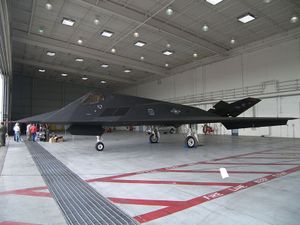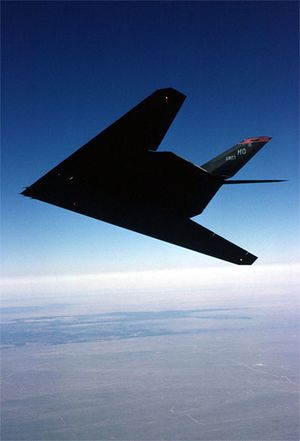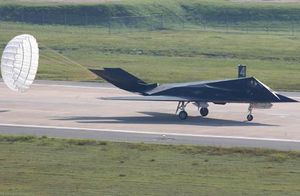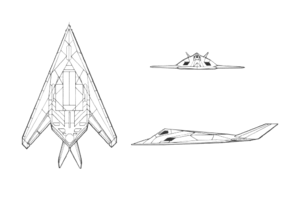PlaneSpottingWorld welcomes all new members! Please gives your ideas at the Terminal.
Lockheed F-117
| F-117 Nighthawk | |
|---|---|
| Type | Stealth bomber/attack aircraft[1] |
| Manufacturer | Lockheed Martin |
| Maiden flight | 1981-06-18 |
| Introduced | October 1983 |
| Retired | 2008[2] |
| Status | Active |
| Primary user | United States Air Force |
| Number built | 59 (55 active) |
| Unit cost | US$45 million in 1983 |
| Developed from | Lockheed Have Blue |
The Lockheed F-117A Nighthawk is the world's first operational aircraft completely designed around stealth technology. Flown solely by the United States Air Force, it is a direct descendant of the Have Blue stealth prototype program.
The F-117A was widely publicized during the Gulf War. The Air Force has been trying to retire the F-117, due mainly to the deployment of the more effective F-22 Raptor. The Air Force is planning to retire the F-117 from October 2006 to 2008,[3][4] and no new pilots will be trained to fly the plane.[5][6][7]
Contents
Designation
The "F-" designation for this aircraft has not been officially explained; however, it seemed to use the pre-1962 USAF fighter sequence like the F-111. Other modern aircraft also have old pre-1962 numbers (such as the B-52, C-130, and a number of lesser known aircraft), but the F-117 seems to be the only later aircraft not to use the unified sequence that began in 1962. Most modern U.S. military aircraft use post-1962 designations which follow (somewhat) predictable pattern whereby "F-" was usually an air-to-air fighter, "B-" was usually a bomber, "A-" was usually a ground-attack aircraft, and "C-" was a cargo plane. Examples of the foregoing include the F-15 Eagle, the B-2 Spirit, the A-6 Intruder, and the C-130 Hercules. Still, since the Stealth Fighter is actually primarily a ground-attack plane, the fact that it retains an "F-" designation is one of the reasons there are several other theories. The USAF has always been more proud of its fighters than its ground-attack aircraft, which are sometimes denigrated as "mud movers."[8] Officials may have felt that they could more easily generate political and military support for the radical new aircraft if it were called a "fighter" rather than a bomber or attack plane. Or, the "F-" designation may have been part of the attempt to keep the Nighthawk secret (the program was classified until the late 1980s). This misdirection could have also served to keep the Nighthawk from violating treaties or angering other countries. During development the term 'LT', for Logistics Trainer, was often used. The Lockheed U-2, for example, should have had "R" for reconnissance instead of a "U" for utility, but, was purposely given the wrong letter to cover its true mission.
Also, a recent televised documentary quoted a senior member of the F-117A development team as saying that the top-notch fighter pilots required to fly the new aircraft were more easily attracted to an F- plane, as opposed to a B- or A- aircraft.[9] There has been something of a class distinction between fighter and bomber crews, particularly in the days of the Strategic Air Command (1945-1991), and flying one type often limited a pilot's prospects for flying the other.[citation needed]
The USAF maintains that the F-117A can carry air-to-air missiles, giving it air-to-air combat capability in addition to its primary air-to-ground mission. While that may be technically true, the aircraft is of unknown capability in air-combat. It is likely a poor dogfighter, but there is no expert opinion on its other abilities.
There is some conjecture about its abilities. It has a subsonic top speed, far slower than virtually every fighter plane since the 1960s. It is said that it cannot turn at greater than 5 g,[citation needed] though the information is classified. It lacks the radar to guide longer-range missiles, and does not carry shorter-range ones for self-defense. Either radar or a helmet mounted sight system is normally used for initial targeting of a short range infra-red guided missile. The lack of radar makes the use of any sort of AAM unlikely. USAF officials once considered putting AIM-9 Sidewinder air-to-air missiles on the F-117—pilots were even trained to fire them—but there is no evidence that AIM-9s have ever been loaded aboard. Its stealth capabilities makes it hard to locate by other fighters and target with radar tracking air-air missiles.
Nicknames
Before it was given an official name, the engineers and test pilots referred to the ungainly aircraft, which went into hiding during daylight to avoid detection by Soviet satellites, as "Cockroach", a name that is still sometimes used. The aircraft's official nickname is "Night Hawk", but the variant "Nighthawk" is also frequent.[10] As it prioritised stealth over aerodynamics, the first model was nicknamed "The Hopeless Diamond".[11] Similarly, it earned the nickname "Wobblin' Goblin" due to its alleged instability at low speeds; according to F-117 pilots, the nickname is undeserved.[12] Locals in the area around Holloman Air Force Base refer to the aircraft simply as the "Stealth".
Design and operation
About the size of an F-15C Eagle, the single-seat F-117A is powered by two non-afterburning General Electric F404 turbofan engines, and has quadruple-redundant fly-by-wire flight controls. It is air refuelable. In order to lower development costs, the avionics, fly-by-wire systems, and other parts are derived from the F-16 Fighting Falcon, F/A-18 Hornet and F-15E Strike Eagle. The parts were originally described as spares on budgets for these aircraft, to keep the F-117 project secret. [citation needed]
Among the penalties for stealth are 30% lower engine power, a very low wing aspect ratio, and a high sweep angle needed to deflect incoming radar waves to the sides.
The F-117A is equipped with sophisticated navigation and attack systems integrated into a digital avionics suite. It carries no radar, which lowers emissions and cross-section. It navigates primarily by GPS and high-accuracy inertial navigation. Missions are coordinated by an automated planning system that can automatically perform all aspects of a strike mission, including weapons release. Targets are acquired by a thermal imaging infrared system, slaved to a laser that finds the range and designates targets for laser-guided bombs.
The F-117A's split internal bay can carry 5,000 lb (2,300 kg) of ordnance. Typical weapons are a pair of GBU-10, GBU-12, or GBU-27 laser-guided bombs, two BLU-109 penetration bombs, two Wind- Corrected Munition Dispensers (WCMD), or two Joint Direct Attack Munitions (JDAMs), a GPS/INS guided stand-off bomb. It can theoretically carry two examples of nearly any weapon in the USAF inventory, including the B61 nuclear bomb. There are a number of bombs that it cannot carry, either because they are too large to fit in its bomb bay, or are incompatible with the F-117's carry system.
History
The decision to produce the F-117A was made in 1973, and a contract awarded to Lockheed Advanced Development Projects, popularly known as the "Skunk Works," in Burbank, California. The program was led by Ben Rich. The first flight was in 1977, only 31 months after the full-scale development decision. The first F-117A was delivered in 1982, operational capability was achieved in October 1983, and the last delivery was in the summer of 1990. The Air Force denied the existence of the aircraft until 1988, then in April 1990 an example was put on public display at Nellis Air Force Base, Nevada, attracting tens of thousands of spectators.
Current inventory is 54 airplanes; 36 of those are combat-ready, the rest are for training, etc.
During the program's early years, from 1984 to mid-1992, the F-117A fleet was based at Tonopah Test Range, Nevada where it served under the 4450th Tactical Group. The 4450th was absorbed by the 37th Tactical Fighter Wing in 1989. In 1992, the entire fleet was transferred to Holloman Air Force Base, New Mexico, where it was placed under the command of the 49th Fighter Wing. The move eliminated the need for Key Air flights, which flew 22,000 passenger trips on 300 flights from Nellis to Tonopah per month.
As the Air Force has stated,[1] "Streamlined management by Aeronautical Systems Center, Wright-Patterson AFB, Ohio, combined breakthrough stealth technology with concurrent development and production to rapidly field the aircraft... The F-117A program demonstrates that a stealth aircraft can be designed for reliability and maintainability." The aircraft maintenance statistics are comparable to other tactical fighters of similar complexity. Logistically supported by Sacramento Air Logistics Center, McClellan AFB, California, the F-117A is kept at the forefront of technology through a planned weapon system improvement program located at USAF Plant 42 at Palmdale, California.
Combat
The F-117 has been used several times in war. Its first mission was during the United States invasion of Panama in 1989. During that invasion two F-117A Nighthawks dropped two bombs on Rio Hato airfield. Later, during the Gulf War, it performed well by dropping smart bombs on Iraqi military targets. It has since been used in the Kosovo War in 1999, the Operation Enduring Freedom and in the 2003 invasion of Iraq.
Combat losses
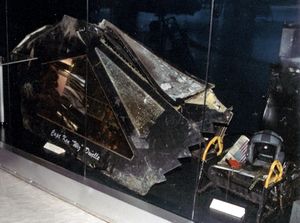
One F-117 has been lost in combat, to Serbian forces. On March 27, 1999, during the Kosovo War, the 3rd Battalion of the 250th Missile Brigade under the command of Colonel Zoltán Dani, equipped with the Isayev S-125 'Neva-M' (NATO designation SA-3 'Goa'), downed F-117A serial number 82-806 with a Neva-M missile. According to NATO Commander Wesley Clark and other NATO generals, Serb air defenses found that they could detect F-117s with their radars operating on long wavelengths. This made them visible on radar screens. The pilot, Captain Ken "Wiz" Dwelle, survived and was later rescued by NATO forces. However, the wreckage of the F-117 was not promptly bombed, and the Serbs are believed to have invited Russian personnel to inspect the remains, inevitably compromising the US stealth technology.[13] The United States actually considered bombing the remains of the downed aircraft, to prevent possible Russian acquisition of American technology. The United States decided not to, and the remains can still be seen by civilians today.
The SAMs were most likely guided manually with the help of thermal imagers and laser rangefinders included in the Pechora-M variant of the SA-3s believed to have been used. Reportedly several SA-3s were launched, one of which detonated in close promixity to the F-117A, forcing the pilot to eject. According to an interview, Zoltán Dani was able to keep most of his missile sites intact and had a number of spotters spread out looking for F-117s and other aircraft. Zoltán and his missile crews guessed the flight paths of earlier F-117As from occasional visual and radar spottings and judging from this information and what target had just been bombed, Zoltán and his missile battery determined the probable flight path of F-117A #82-806. His missile crews and spotters were then able to locate it and fire their missiles. Zoltán also claims to have modified his radars to better detect the F-117A, but he has not disclosed what was changed. Parts of the shot-down aircraft are now presented to the public in the Museum of Yugoslav Aviation in Belgrade.
Some sources claim a second F-117A was also damaged during a raid in the same campaign, and although it made it back to its base, it never flew again.[14]
Future
With its successes in the Kosovo and Iraq Wars and its high mission-capable rate, the F-117 has secured its place as the aerospace "tip of the spear" -- serving to blind the enemy by destroying command, control and radar early in the campaign. However the F-117 is nonetheless designed with late 1970s technologies. Its stealth technology, while still more advanced than that of any other aircraft but the B-2 Spirit and F-22A, is maintenance heavy. Furthermore, the facet-based stealth design (which has aerodynamic cost) represents an old counter-radar technique that has since been greatly refined. Consequently there has been a preliminary decision to retire the fleet in 2008.
The increase of production of the F-22A by four planes and its entry as an operational aircraft into the US Air Force has created debate about retiring the F-117 fleet. A draft version of the 2006 Quadrennial Defense Review and the 2007 Defense Budget that were leaked proposed retiring the entire fleet to make room for buying more F-22As.[5] This plan was removed from both the final 2007 Budget and the final QDR.[15]
Critics[attribution needed] say that efforts to retire the F-117 (a single-purpose ground attack plane), is influenced by the largely former-fighter pilots that populate the highest ranks of the Air Force. Furthermore, critics contend that the F-117A Nighthawk is able to carry five thousand pounds of ordnance in its internal bay (even including a B61 nuclear bomb) and remain stealthy, whereas the F-22A is only able to carry two thousand pounds of ordnance in its internal bays and can only carry larger bombs on its external pylons, thereby compromising its stealth and maneuverability.
Supporters of the proposal, however, argue that the high maintenance costs and older stealth technology that is vulnerable to long-wavelength radar, combined with a subsonic speed limit, makes the F-117 more dangerous to fly. They contend that the F-22A is the logical successor considering that:
- Its stealth is nearly as advanced as the B-2's, and reportedly more effective than the F-117's.
- It can fly at supersonic speeds without using afterburners and thus can reach targets and transit high-threat area faster.
- Its radar-absorbing material requires far less maintenance than that of the F-117.
- The new 250 lb small diameter bomb (SDB) has entered service. It is designed specifically to fit in the F-22A's internal munitions bays, and provides the same penetrating power as a larger 2000 lb BLU-109 bomb.
- The F-22 has more advanced avionics than the F-117, providing better situational awareness of possible ground or air threats.
- As the F-22 is a fighter aircraft, it is able to self escort on many of its strike missions.
Although the proposal of the retirement of the F-117 fleet was withdrawn, the Air Force has closed the F-117 pilot school, and has announced the retirement of the F-117[16] This puts the F-117's future in doubt. There have been rumors that the F-117 will be completely out of service by 2018
Interestingly, several of the F-117s were painted in a grey camouflage pattern in an experiment to determine the effectiveness of the F-117's stealth during daylight conditions. If the experiment is successful, it might lead to part or all of the fleet changing from their trademark black to this new color scheme, enabling, for the first time, daylight operations in warzones. As of early 2006 the outcome of this experiment is unknown. Also, 2004 and 2005 saw several mid-life improvement programs being implemented on the F-117, including an avionics upgrade.
Popular culture
- A Sprint commercial in the 1990s featured a large schematic drawing of the F-117, which was then subsequently identified incorrectly by Candice Bergen, their speaker, as a B-2.
- During the 1999 bombing of Serbia, after an F-117 was shot down by Serbian troops, a Serbian performing group Indexovo radio pozorište composed a satirical song "El kondor pada" about its pilot.
- In the 1980s, the Jane's Information Group misidentified the F-117 as the F-19, and featured fictitious artwork in All the World's Aircraft. Modelmakers Testors and Monogram both released hypothetical "F-19 Stealth" models; neither bore any resemblance to the real F-117.
- Macross 7 TV Anime Series' (1994) VF-17D Nightmare's design is based on F-117 Nighthawk.
Specifications
General characteristics
- Crew: 1
- Length: 63 ft 9 in (20.08 m)
- Wingspan: 43 ft 4 in (13.20 m)
- Height: 12 ft 9.5 in (3.78 m)
- Wing area: 780 ft² (73 m²)
- Empty weight: 29,500 lb (13,380 kg)
- Loaded weight: 52,500 lb (23,800 kg)
- Powerplant: 2× General Electric F404-F1D2 turbofans, 10,600 lbf (48.0 kN) each
Performance
- Maximum speed: 610 knots (702 mph, 1,130 km/h)
- Range: 535 mi (465 nm, 860 km)
- Service ceiling: 33,000 ft (10,000 m)
- Wing loading: 65 lb/ft² (330 kg/m²)
- Thrust/weight: 0.40
Armament
- 2× internal weapons bays with one hardpoint each (total of 2 weapons) equipped to carry:
- Bombs:
- BLU-109 hardened penetrator
- GBU-10 Paveway II laser-guided bomb
- GBU-27 laser-guided bomb
- Missiles:
- AGM-65 Maverick air-to-surface missiles
- AGM-88 HARM air-to-surface missiles
- Bombs:
References
- ↑ 1.0 1.1 Factsheets : F-117A Nighthawk. United States Air Force Link (October 2005).
- ↑ http://www.scsun-news.com/news/ci_5103964
- ↑ http://www.elpasotimes.com/ci_5089211
- ↑ http://www.boston.com/news/globe/ideas/articles/2007/02/04/now_you_see_it/
- ↑ 5.0 5.1 "US Plans to Retire B-52s, C-21s, F-117 & U-2 for more F-22s", Defense Industry Daily, 2006-01-12. Retrieved on 2007-01-20.
- ↑ Rogers, Keith. "Stealth jets bound for 'boneyard'", Las Vegas Review-Journal, 2006-02-16. Retrieved on 2007-01-20.
- ↑ "F-117 pilot school closes", Air Force Times.
- ↑ Air War in Vietnam. Acepilots.com (2003). Retrieved on 2007-01-20.
- ↑ . (2006). Stealth and Beyond: Air Stealth [TV-series]. The History Channel.
- ↑ Model Designation of Military Aerospace Vehicles (PDF) page 38. United States Department of Defense (2004-05-12). Retrieved on 2007-01-20.
- ↑ F-117 History. F117reunion.com. F-117 Stealth Fighter Association. Retrieved on 2007-01-20.
- ↑ Rhodes, Jeffrey P. (July 1990). "The Black Jet". Air Force Magazine 73 (7). Retrieved on 2007-01-20.
- ↑ Smith, Charles R.. "Russia Offers India $8 Billion Weapons Deal", NewsMax.com, 2001-12-12. Retrieved on 2007-01-20.
- ↑ Riccioni, Everest E., Colonel, USAF, retired (2005-03-08). Description of our Failing Defense Acquisition System (PDF). Project on government oversight.
- ↑ Removed from budget. Air Force Times.
- ↑ Staff Sergeant Matthew Bates. "F-117: A long, storied history that is about to end", Air Force Link, 2006-10-28. Retrieved on 2007-10-20.
External links
- F-117 Anniversary
- F-117 Crash at Air Show in Baltimore
- Air Force Link - Fact Sheet : F-117A Nighthawk
- The 49th Fighter Wing at Holloman Air Force Base is a dead link; use the Internet Archive link here instead
- U.S. Air Force F-117A Nighthawk - Wallpaper
- CNN - U.S. plane shot down, pilot rescued - March 27, 1999
- CNN - Downed NATO pilot rescued, U.S. officials say - March 27, 1999
- CNN - Stealth Nighthawk downed in Yugoslavia - March 28, 1999
- CNN - NATO stealth missions continue after crash - March 28, 1999
- www.f-117a.com - comprehensive site
- FAS F-117A Nighthawk
- F-117 In Action
- NY Times - U.S. Stealth Fighter Is Downed in Yugoslavia
- http://www.nytimes.com/library/world/europe/032899kosovo-rdpa.1.html
- Interception of F-117 by Austrian Airforce
- Venik's Aviation—A US F-117 Night Hawk stealth bomber shot down over Yugoslavia
- Stealth plane set for mothballing by Air Force
- (German) Austrian article about interception of F-117
Related content
Related development
Comparable aircraft
Related lists
- List of active United States military aircraft
- List of fighter aircraft
- List of Lockheed aircraft
- List of military aircraft of the United States
See also
Airliners and Civil Transports: Vega · Electra · Electra Junior · Super Electra · Lodestar · Constellation · Saturn · L-188 Electra · L-402 · JetStar · L-1011 TriStar
Military Transports : C-64 · C-121 · R6V · C-130 Hercules · C-141 Starlifter · C-5 Galaxy
Fighters: F-22 Raptor · F-35 Lightning II · F-94 Starfire · F-104 Starfighter · F-117 Nighthawk · P-38 Lightning · P-80 Shooting Star · T-33 Shooting Star
Patrol and reconnaissance : Hudson · PV-1 Ventura · PV-2 Harpoon · P-2 Neptune · P-3 Orion · CP-140 Aurora/CP-140A Arcturus · U-2 · SR-71 Blackbird · S-3 Viking
Lists relating to aviation | |
|---|---|
| General | Timeline of aviation · Aircraft · Aircraft manufacturers · Aircraft engines · Aircraft engine manufacturers · Airports · Airlines |
| Military | Air forces · Aircraft weapons · Missiles · Unmanned aerial vehicles (UAVs) · Experimental aircraft |
| Notable incidents and accidents | Military aviation · Airliners · General aviation · Famous aviation-related deaths |
| Records | Flight airspeed record · Flight distance record · Flight altitude record · Flight endurance record · Most produced aircraft |
ar:أف 117 نايت هوك cs:Lockheed F-117 Nighthawk de:Lockheed F-117 es:F-117 Nighthawk fr:Lockheed Martin F-117 Night Hawk ko:F-117 it:Lockheed F-117 Nighthawk he:F-117 נייטהוק hu:F–117 Nighthawk nl:Lockheed Martin F-117 Nighthawk ja:F-117 (攻撃機) no:Lockheed F-117 Nighthawk pl:Lockheed F-117 Nighthawk pt:F-117 Nighthawk ro:F-117 Nighthawk ru:F-117A sr:Ф-117 Ноћни соко fi:F-117A Nighthawk sv:F-117 Nighthawk vi:F-117 Nighthawk tr:F-117 zh:F-117夜鷹戰鬥機
